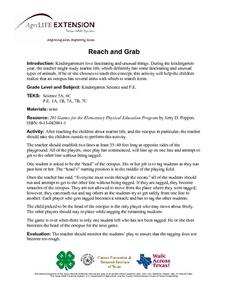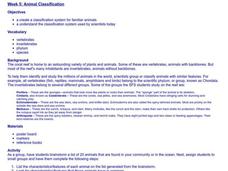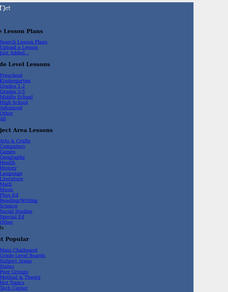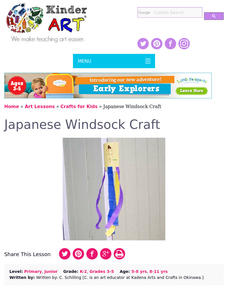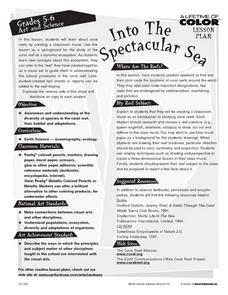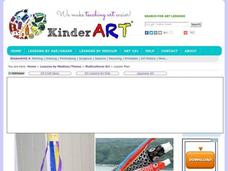Curated OER
Octopus Project: Ceramics
Kids make an octopus out of clay. They practice their sculpting and modeling skills such as pinch pot and slurry technique while sculpting an octopus.
Curated OER
Octopus Lesson Plan
Students read about the octopus and create an octopus out of ink and a deflated balloon. In this octopus lesson plan, students discuss the different defense mechanisms of the octopus and use the ink to demonstrate what happens if the...
Curated OER
Octopus Legs
Students have oceans of fun transforming a wienie into an octopus they can eat! After counting, cutting halves and fourths, observing steam and the effects of heat, they mix colors as they create a yummy dipping sauce from mustard and...
Curated OER
Eight Arms & Counting
Students identify the unique characteristics of the octopus. Then they fashion a model of this unique sea creature. Students also imaginatively decorate their model octopus. Finally, they research the different functions of the octopus's...
Curated OER
The Amazing Octopus
Students design imaginary animals that are able to blend into their backgrounds. In this biology lesson plan, students will learn the importance of camouflage in protecting animals from predators. Students will select a peer to act as...
Curated OER
Create a Hawaiian Tako Lure
Students create a tako lure. In this Hawaiian culture lesson, students research how Hawaiians use natural resources to survive. Students are introduced to new vocabulary and create an octopus lure.
Curated OER
Fish, Fish: Teaching K Students About Things That Live in the Sea
Students participate in activities designed to help them connect the words to the animals they are studying. Octopus is reinforced through playing a game, "Octopus Tag." Students play a cooperation game of passing bean bags from student...
Curated OER
Reach and Grab
Students examine the different types of marine life and participate in an activity to show the many arms of an octopus.
Curated OER
Create a Youth Consumer Magazine
To underscore the importance of being informed consumers, kids check out youth consumer magazines and websites and then create their own. Although no detailed plans are included in the resource, it is packed with ideas and suggestions.
Curated OER
A Weigh we Go!
Here are some cross-curricular activities whil should help your kids understnad weight measurements and grammar. In this grammar and math lesson, students read the book Skittles Riddles and practice counting and balancing skittles. They...
Curated OER
Pre-School
Students draw their hand, and color their drawing. They count the number of fingure on thier hand. Students count the number of arms on the marine animal in the picture. They count the number of legs and claws on the marine animal in the...
Curated OER
Something Fishy Going On
Students create a video animation of how Swimmy gathered his fish friends together to form a great big fish that would frighten the predator tuna away. In art class each child create a small red fish which gets displayed in the ocean...
Curated OER
Blue Planet: Seasonal Seas
Students study and research marine invertebrates. In this marine lesson plan students create an illustrated report and help complete a class exhibit.
Curated OER
Animal Classification
Young scholars list characteristics and features of animals found in their community. They then group the animals according to how they are similar and different and create names for each group. They then create a chart of their...
Curated OER
Who Lives in the Sea? A class book (Elementary, Science)
Students, assigned an alphabet letter, do research on a sea animal whose name begins with that assigned alphabet. All of the assignments then be turned into a class book.
Curated OER
Japanese Abstract Wind Sock
Learners use paper bags to create a Japanese wind sock with original abstract art.
Curated OER
Dissecting Squid
Second graders explore biology by dissecting an animal. In this squid anatomy lesson, 2nd graders collaborate in pairs to investigate the inner body systems of a recently deceased squid. Students utilize plastic knives to cut the squid...
Curated OER
Off To a Good Start
In this physical education success worksheet, young scholars create a bulletin board outlining strategies that they can use to be successful throughout the year in a physical education class. In small groups, they discuss ways to be...
Curated OER
Into the Spectacular Sea
Students research coral reefs as dynamic ecosystems and the part that each organism plays within that ecosystem. They create a mural of a coral reef.
Curated OER
Underwater Nature Trails
Students research dive sites on an underwater nature trail that would introduce divers to the wonders of the reef surrounding South Caicos. They then recreate each dive site using shoe box diorama and create an information station at...
Curated OER
Texture Scavenger Hunt
Students work together to complete a scavenger hunt searching for objects with different textures. After finding the object, they make full page rubbings of each and later make a complete drawing of the item. They collect all of their...
Curated OER
Japanese Abstract Wind Sock
Students create Abstract Wind Socks using brown paper bags, markers, kite string, and basic art supplies in this Art lesson for the elementary classroom. Abstract concepts are emphasized and it is recommended to only use primary colors.
Other popular searches
- Octopuses
- Octopus Kindergarten
- Octopus Dissection
- Kelp Forest Octopus
- Octagon Octopus
- Origami Octopus
- Octopus Facts
- Octopus Food Chain
- Octopus Habitat
- Octopus Activities
- Books About Octopuses
- Octopus Characteristics









